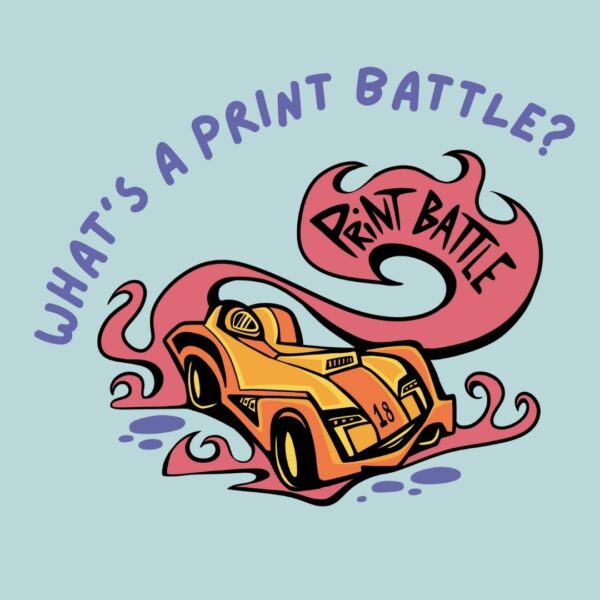Rebecca Kautz’s solo painting show at Madison’s Art Lit Lab combines an idiosyncratic exploration of personal subjects buried in a palpable vernacularism that seems to be composed by the way images are spoken – a sort of soluble concrete poetry. What’s remarkable is how her improvisational figuration, unhinged from the mimetic fatigue still alive from the halcyon days of “Bad Painting,” plays catch with facsimiles across the “Lab’s” enormous galleries.

“Awaken By Night Trains” 2024, Acrylic on Canvas, 24” X 20″
Kautz’s “Awaken by Night Trains” picture is a puzzle with little apparent relation to its title except for a half-curtained window revealing an icy blue nocturne. The image depicts an art studio where much nature morte assumes the scale of a canvas and easel rendering. A Robin’s egg blue suit slouches across a stiff-backed chair and wing tips float before a Persian-style carpet of pink roses. On top of a bilious colored chest of drawers two humorously oversized clay sculptures preside over an assemblage of stuffed animals, potted plants, and other thrift store memorabilia. The artist’s king-sized signature endorses a foreground corner of polysemic turmoil.
“Light as a Feather” is a more focused picture, nocturnal again, but in a softly fetishized dreamscape. The sleeping artist floats high in rolling lavender skies above the edge of a small Midwestern town. The only structures are a pink chalet and red brick public building, both of which appear to be constructed of gingerbread. Just below the horizon is a farm crowded with rows of heather and a sloping graveyard with weathered stuffed toy tombstones. Underscoring everything is an indecipherable rebus – stovepipe, alligator, tree stump. Filling every possible space with detail is a craft trope distinctive to quilting, but it’s not that distant from the emphasis on pattern that secures the flatness and pictorial uniformity of the modern.

“Light as a Feather” 2023-24, Acrylic on Canvas, 16″ X 20″
Kautz’s low-tech kitsch displaces at least two generations of neo-naïve artists and decades of unadulterated folk-artists prevalent in the Great Lakes region. An undergraduate study at the School of the Art Institute might account for a taste for some of the early stable of the late Phyllis Kind Gallery, artists whose solitude and self-effacement established a compelling regional and national subject variance. Having been born in Chicago but growing up in a small Northern Illinois town not far from the artist’s home I can identify with the under-defined culture of silo-dotted Burlington rail traffic economies woven into the consciousness of these pictures. I’m always interested in seeing how place representations task national vocabularies of fine art and how local traditions ironically absorb coastal studio practices. Kautz juggles both and also applies them to performance and installation accoutrements of which are also on view here in Madison.

“Shame Project: People Peephole” detail, durational public performance artifact and painting installation, mixed media on wood panel, school chair, high visibility vest, iron on letters, oil cloth, brackets, wood dowels, dimensions variable, 2019-2021/2024
Increasingly contemporary figurative art feels more related to the domain of the neurological than psychological. The imposing knife-work of the artist’s uncanny ruralism carries the burden of loss and the uncertain present in her depictions of place. While it’s tempting to do a close reading of Kautz’s dream imagery that pulses in huddled spaces, it’s more satisfying to measure the grammatical overlap between Surrealist figuration and the neurotransmitted spirits that have persisted in rural American art since mid-century.
- Sub-Rural #49.5, Door County Contemporary Art Fair - June 15, 2025
- Sub-Rural #49, Intuit Art Museum Redux - June 2, 2025
- Sub-Rural #49, Caroline Kent - May 1, 2025




